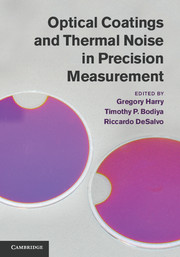Book contents
- Frontmatter
- Contents
- List of contributors
- Foreword
- Preface
- 1 Theory of thermal noise in optical mirrors
- 2 Coating technology
- 3 Compendium of thermal noises in optical mirrors
- 4 Coating thermal noise
- 5 Direct measurements of coating thermal noise
- 6 Methods of improving thermal noise
- 7 Substrate thermal noise
- 8 Cryogenics
- 9 Thermo-optic noise
- 10 Absorption and thermal issues
- 11 Optical scatter
- 12 Reflectivity and thickness optimization
- 13 Beam shaping
- 14 Gravitational wave detection
- 15 High-precision laser stabilization via optical cavities
- 16 Quantum optomechanics
- 17 Cavity quantum electrodynamics
- References
17 - Cavity quantum electrodynamics
Published online by Cambridge University Press: 05 January 2012
- Frontmatter
- Contents
- List of contributors
- Foreword
- Preface
- 1 Theory of thermal noise in optical mirrors
- 2 Coating technology
- 3 Compendium of thermal noises in optical mirrors
- 4 Coating thermal noise
- 5 Direct measurements of coating thermal noise
- 6 Methods of improving thermal noise
- 7 Substrate thermal noise
- 8 Cryogenics
- 9 Thermo-optic noise
- 10 Absorption and thermal issues
- 11 Optical scatter
- 12 Reflectivity and thickness optimization
- 13 Beam shaping
- 14 Gravitational wave detection
- 15 High-precision laser stabilization via optical cavities
- 16 Quantum optomechanics
- 17 Cavity quantum electrodynamics
- References
Summary
Cavity quantum electrodynamics (cavity QED) describes the interactions of single atoms and single photons in a resonator. In the laboratory, state-of-the-art experiments are able to observe the dynamics of these simple yet fundamental quantum systems. The recent development of quantum information science has also introduced a new role for cavity QED systems as quantum interfaces, in which information can be coherently mapped between photonic and atomic quantum bits.
Groundbreaking optical cavity QED experiments in the past twenty years would not have been possible without the technological development of mirror coatings with extremely low scatter and absorption losses. Thermal noise has typically played a smaller role in cavity QED experiments but in certain instances is nevertheless important to consider.
In this chapter, we begin with an overview of optical cavity QED experiments and some of the central questions that they address. It is hoped that this description, while by no means exhaustive, will provide a window for the nonspecialist into basic techniques and motivations in the field. We then turn to focus on the roles played by scattering and absorption loss and mechanical loss. We discuss how these losses have set limits on feasible experiments and the extent to which improvements may be possible.
Experimental realizations of cavity QED systems
An idealized cavity QED system consists of one atom placed between two highly reflective mirrors (Figure 17.1). In this model, a single atomic transition interacts with photons in a single cavity mode; the atom is often pictured at an antinode of the cavity standing wave, where it has a maximal dipole interaction with the cavity field.
- Type
- Chapter
- Information
- Optical Coatings and Thermal Noise in Precision Measurement , pp. 280 - 295Publisher: Cambridge University PressPrint publication year: 2012

